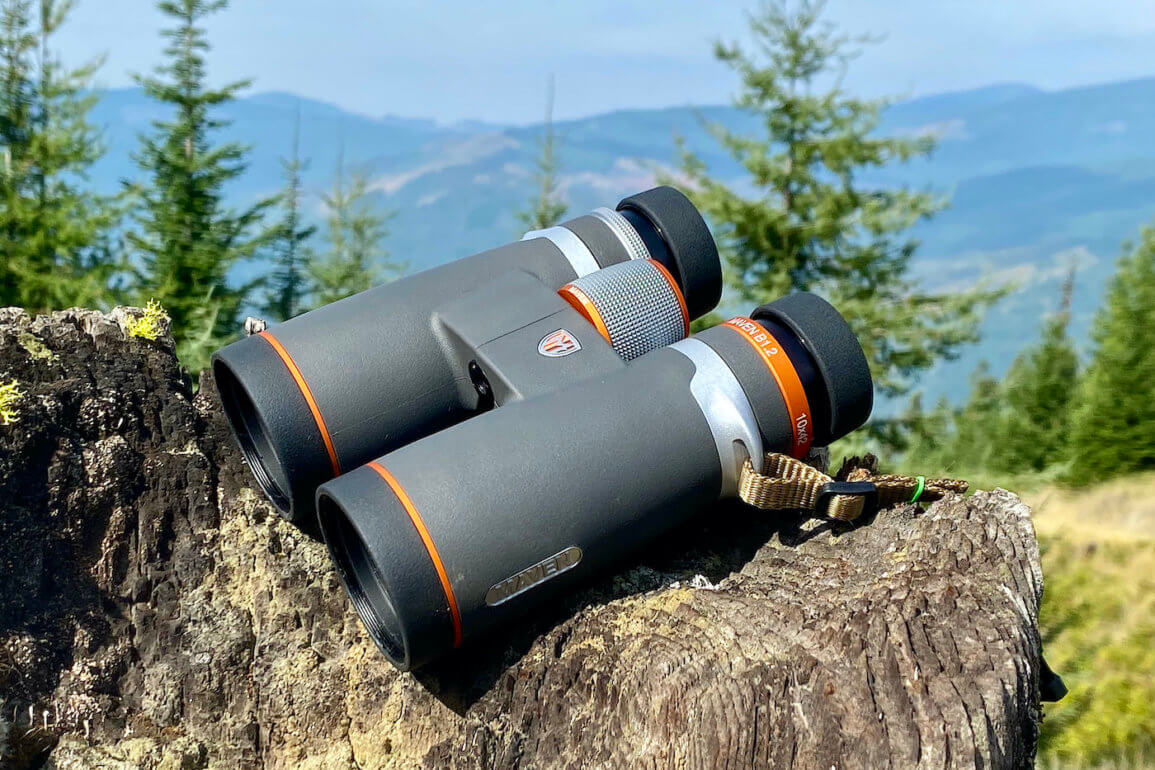The newly upgraded Maven B1.2 binocular is now lighter, brighter, and more compact than the previous B.1. Better yet, it has improved coatings and a larger Schmidt-Pechan prism that delivers a wider field of view.
To get us a closer look, Maven sent Man Makes Fire a review unit. After testing the Maven B1.2 in 10×42, as well as putting it to work while archery elk hunting in Idaho, this is what we learned:
Maven B1.2 Review
I very much liked the original B.1, which I hunted with for two years (full original B.1 review here). Still, I have to tell you: The new Maven 10×42 B1.2 is much better.
How is that possible?
For me, the B1.2 delivers two major improvements in usability. First, the new B1.2 is smaller so it’s easier to handle. It’s .5″ shorter than the B.1 and it weighs 2.7 oz less than the B.1.
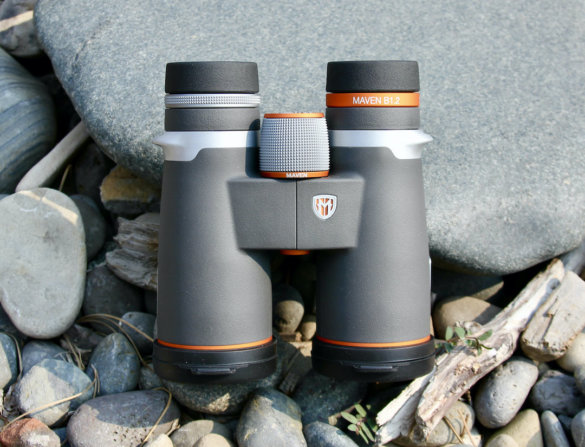
These differences might seem like relatively minor changes, but in the field, they’re not. When you need to use one hand to grab your binoculars and take a quick look at what you hope is an elk or deer, the lighter and more compact B1.2 binoculars make this much easier. In addition, when I’m standing up and looking through the B1.2, I can hold it steadier for longer periods of time. That leads to an in-the-field information boost, and when I’m trying to find an elk, I’ll take any edge I can get.
To put this in perspective, consider this: Last year, on big-mile days I found myself thinking about taking the lighter (but not as crisp) Maven C.1 10×42 binoculars — just to save weight and gain some one-handed agility. This year with the B1.2 in 10×42, that’s no longer a question at all.
Bigger Field of View
The new B1.2 now includes a wider field of view. The new FOV is 362′ — which is just 21′ wider than the previous FOV.
How is 21 feet a big deal?
While the edge-to-edge clarity of the B1.2 binoculars is very good, having a wider field of view can help increase the perceived sweet spot as you’re looking through the binoculars. This lets your brain process more information and maybe see movement or an object that you might not otherwise notice. For me, technically getting a wider view isn’t that big of a deal when I’m trying to examine a hillside piece-by-piece . . . but how I feel when I do this, which can sometimes get tedious, makes a difference. This FOV boost makes the Maven B1.2 binoculars feel quite a bit more immersive than the B.1s.

To be fair, the B.1s are already very good. If you already have a set of B.1s, the overall specifications mean you don’t have to upgrade. At the same time, here’s a warning: If you suffer from gear lust, don’t look through the new Maven B1.2 binoculars.
Check out Maven’s Customization Builder to see cool camo and color patterns!
Improved Coatings, Better Light Transmission
The biggest B1.2 surprise to me is that Maven found a way to improve its fully-multicoated ED glass. In case you’re wondering, optics manufacturers coat their lenses with secret sauces and ions and use techniques that reduce light refraction so that more light passes correctly through each piece of glass.
The glass itself is ED glass made in Japan and assembled in Wyoming — just like all the glass in Maven’s high-end optics. ED stands for extra-low dispersion, and it’s basically high-end glass that improves the delivery of wavelengths of light to reduce chromatic aberration (which I’ll get to below).
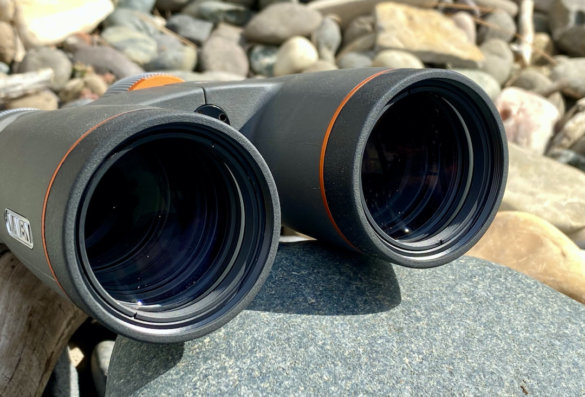
However, the new coatings, in combination with the new construction of the prism, has somehow resulted in a 3.6% boost of light transmission — up from 90.9% to 94.5%. That’s a very impressive gain. Incidentally, many optics companies don’t publish this sort of data, but Maven publishes a massive binocular comparison chart that shows key specifications across its entire line. So cool.
But wait, there’s more to this story: The new Maven B1.2 10×42 binocular now competes very closely, and sometimes beats, the light transmission percentages delivered by Maven binoculars with Abbe-Koenig type prisms. In general, Abbe-Koenig prisms deliver the best light transmission but they are heavier, longer, harder to manufacture, and cost more. The fact that the relatively short B1.2 with Schmidt-Pechan prisms can compete here is, again, impressive.
Chromatic Aberration
What is a chromatic aberration? In general, when you can see an outline of translucent color tracing an object’s edges in a high-contrast situation, you’re seeing a chromatic aberration. It occurs when different wavelengths of color don’t converge at exactly the same spot after passing through a lens. It’s more noticeable at higher magnifications.
I can spot a small bit of chromatic aberration with the Maven B1.2. In side-by-side testing with the B.1, the chromatic aberration effect is very similar — and quite small.
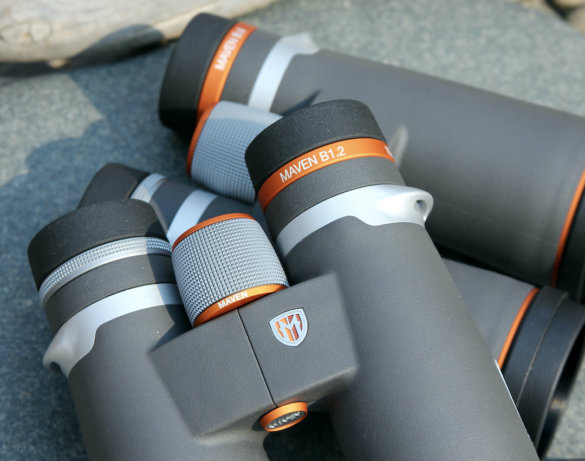
To test for chromatic aberrations, you can look through binoculars at a U.S. Air Force black-and-white test chart . . . or you can find a non-moving high-contrast subject in the sky. For example, if you look at a dark part of a tree branch against a bright sky, you can usually see some color fringing. In the Maven B1.2, it’s a very thin purplish hue. (Your brain has a tendency to ignore this, so with good glass you have to look hard to find it.)
At home, there’s a tree I use for this purpose — in addition to a U.S. Air Force test chart taped to my garage door when I’m more serious.
So, is this a problem?
For the vast majority of people it’s not. First, the color fringing effect is very small. Second, most people’s brains tend to filter it out as they process images. My recommendation? You won’t notice it unless you work very hard to find it. So don’t worry about it. Everything else is so rich and vibrant you won’t care.
Shop the new B.12 direct from Maven!
Maven B1.2 Specifications:
| Magnification | 8x | 10x |
| Obj. Lens Diameter | 42mm | 42mm |
| Exit Pupil | 5.25mm | 4.2mm |
| Field of View @1,000 yds | 420′ | 362′ |
| Brightness | 27.6 | 17.6 |
| Light Transmission % | 93.95% | 94.50% |
| Twilight Factor | 18.3 | 20.5 |
| Weight | 26.8 oz | 26.8 oz |
| Dimension WxHxD | 5.2″ x 5.7″ x 2.2″ | 5.2″ x 5.7″ x 2.2″ |
| Eye Relief | 18.1mm | 17.8mm |
| Near Focus | 4.9′ | 4.9′ |
| Prisms Type | Wide Angle Schmidt-Pechan | Wide Angle Schmidt-Pechan |
| Prism Reflective Coating | Dielectric Coating | Dielectric Coating |
| ED Glass | Yes | Yes |
| Diopter Correction (DPT) | +/-3 | +/-5 |
| Waterproof/Pressure Testing | IPX7 (1m for 30 minutes) | IPX7 (1m for 30 minutes) |
| Functional Temp Range | -13°~140°F | -13°~140°F |
| Frame Material | Magnesium | Magnesium |
| Internal Gas Purge | Nitrogen | Nitrogen |
| Tripod Adaptable | Yes | Yes |
| Country of Origin | Japanese components, assembled in the U.S. | Japanese components, assembled in the U.S. |
Price-to-Value Ratio
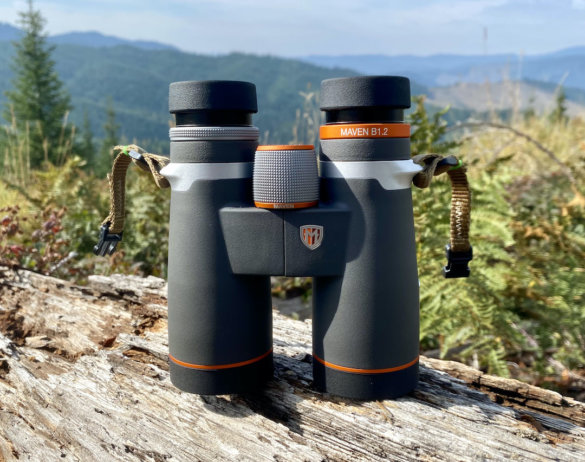
Maven is a relatively small Wyoming-based optics company. A key part of its business model and competitive nature comes from its direct-to-consumer business model. By cutting out the middle man, so to speak, Maven can deliver great optics that cost less than the competition.
The Maven model also lets the company avoid negotiating with retailers over price points and stock levels — which can affect product ingenuity, quality and consumer pricing.
The drawback to Maven’s model is that you can’t walk into a Cabela’s or Bass Pro Shops brick-and-mortar store and look through a Maven optic. You have to order it online.
Maven’s Customization Program
Speaking of ordering online, Maven has a cool customization program. For an additional charge, you can customize the body color with a camo pattern. In addition, you can customize the color of the neck strap rings, focus wheel, ocular lens rings, objective lens rings, tripod/hinge cap, and labeling. And then you can even have the bino engraved with up to 30 characters — which might turn the Maven B1.2 binoculars into a great hunting gift idea. And the kind of optic you’ll eventually pass down to your kids.
Unconditional Lifetime Warranty
The Maven warranty competes with the very best optics warranties in the business: If a Maven optic ever fails — or gets broken — for any reason, you can return it to Maven for a replacement.
But it gets better. Maven will also stand behind a Maven optic as long as it bears their name. This means that if your Maven binoculars fail your son or daughter in 30 years, Maven will still repair or replace them.
Competition & Alternative Options
There are many great binoculars to choose from these days. For the most part, any binocular that’s priced more than $900 or so will be very good. In fact, most midrange binoculars in the $500 price range will be so good that the vast majority of people will never have a need to upgrade. Case in point? The Maven C.1 10×42 and C.3 10×50 are pretty great. At $900-950, the direct-to-consumer pricing of the Maven B1.2 binoculars sets them up to compete well against binoculars that cost twice as much. Here are several other can’t-go-wrong competitive options you might consider:
Vortex Razor HD — The most widely known competitor to the Maven B1.2 is the Vortex Razor HD binocular. Vortex has generated a loyal following over the years by investing heavily in marketing and its customer service department, which also backs a no-questions-asked lifetime warranty. The Razor HDs in 10×42 are slightly taller, slightly lighter, and deliver the same FOV as the B1.2s. The key benefit is that you can find the Razor HD binoculars in brick-and-mortar stores. The key drawback is the increased price. Note: The term “HD” in relation to binoculars tends to be more about marketing a term that consumers have associations with rather than identifying a specific type of glass. When comparing one binocular to another among different manufacturers, “HD” doesn’t actually pinpoint any agreed upon difference. (The Razor HDs do use ED glass, in case you’re wondering.)
Swarovski EL with Swarovision — Pretty much everyone who has ever looked through Swarovski EL Binoculars can appreciate the build quality and optical fidelity. The main benefit of Swarovski EL series is the industry-leading quality. The main drawback is the very high price point.
Zeiss Victory SF — Aside from fantastic glass and overall quality, Zeiss fans appreciate the balance and weight.
Leica Noctivid — The Leica Noctivid in 10×42 rounds out the ultra high-end competition. At 30.3 ounces, they’re a bit heavy compared to the similar binoculars in this class, but the 376′ FOV leads the pack.
Maven B1.2 10×42 Review: The Verdict
All-in-all, the new Maven B1.2 is a worthy upgrade to its B.1 predecessor. If you already have a B.1, the B1.2 will deliver a slight optical boost, but that likely won’t lead to a logical decision to upgrade. If, however, the previous weight and size of the B.1 turned you off, the lighter B1.2 with its more expansive Field of View makes it far more packable and easier to hold steady. The bottom line is, the B1.2 delivers competitive specs, has an excellent price-to-value ratio, and is a delight to use. Very highly recommended.
Get the Gear:
- Maven B1.2 Binoculars — 8×42 & 10×42

